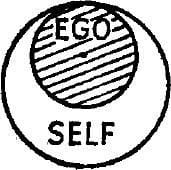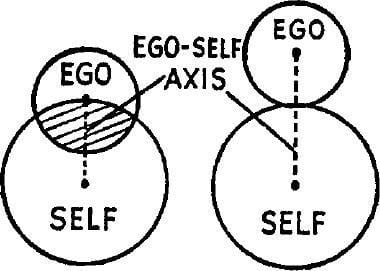
a small circular drawing,
a mandala, which seemed
to correspond to my inner situation
at the time."
Carl Jung
www.jungcurents.com
"毎朝、ノートにスケッチしていた
小さな円形の絵を描いていました。
曼荼羅を描いていました。
その時の私の心の状況に対応するような
その時の私の内面の状況に対応しているように思えた。
カール・ユング
A
【経験上、個々のマンダラは秩序の象徴であり、主に精神的な混乱や方向転換の際に患者に発生する】とある。
全体性」は一見、抽象的な考えに過ぎないように思えるが、それにもかかわらず、経験的なものである。全体性」は一見すると抽象的な考えに過ぎないように見えるが、それにもかかわらず、精神が自然発生的または自律的なシンボルの形で予期している限り、経験的なものである。それは、四位一体や曼荼羅の象徴であり、それらを知らない現代人の夢の中だけではなく、多くの民族や時代の歴史的記録の中にも広く存在している。統一と全体性のシンボルとしての意義は、歴史的にも経験的心理学的にも十分に確認されています。一見、抽象的なアイデアに見えるものでも、実際には存在し、経験することができ、先験的にその存在を示すものである。全体性は、アニマやアニムスのように、主体とは無関係に主体に立ちはだかる客観的な要素であり、後者が影よりも階層的に高い位置にあるように、全体性はsyzygy(アニマとアニムス)のそれよりも優れた位置と価値を主張している。syzygyは、王家の兄と妹のペアによって形成される全体のうち、実際には2つの部分ではないにしても、少なくとも実質的な部分を表していると思われ、それゆえに、相反するものの緊張関係から、統一の象徴として神の子が生まれるのである。
単一性と全体性は、その象徴がイマーゴ・デイ(神イメージ)とはもはや区別できないため、客観的な価値の尺度において最高点に立つ。したがって、神のイメージに関するすべての記述は、全体性の経験的なシンボルにも当てはまる。経験上、個々のマンダラは秩序の象徴であり、主に精神的な混乱や再編成の際に患者に現れることがわかっている。魔法陣としてのマンダラは、暗黒の世界に属する無法な力を束縛して従わせ、混沌を宇宙に変える秩序を描き出したり創造したりする。曼荼羅は、最初は目立たない点として意識の中に入ってきますが、そのシンボルの全容を完全に理解するには、多大な苦労と多くの投影を統合する必要があります。なぜなら、私たちの中にいる神、私たちの上にいる神、キリストと神秘体、個人的なものと超個人的なものであるアートマンなどについての世界的な宣言は、すべて哲学的な知性によって容易に習得することができる形式だからです。これが、あたかもその物自体を手に入れたかのような錯覚の共通の原因となっている。しかし実際には、人はその名前以上のものを手に入れたわけではありません。~CGユング、CW9/2、par. 59 60.
コーパスミスティカム(「神秘的な体」)教会をキリストの「神秘的な体」と呼ぶために使用されていました。
https://en.wikipedia.org/wiki/Corpus_Mysticum
J
現在のパラダイムのマンダラを表現することを学ぶことは、自己の言語を習得することであり、マスターから学ぶ必要があります。ユングでなくても、宇宙のビジョンを自分のマンダラとして解き放つために必要な、インスピレーションに満ちたビジョンの鍵を握る優れた弟子がいるはずです。私はダライ・ラマの砂の曼荼羅を見たことがありますが、何を言っているのか理解できませんでした。ユングのも。私は69歳にして絶望的な学生であり、この内なる精神への素敵な探求は凡庸なものになってしまいました。ユングのマンダラはあなたに何を語りかけていますか?
A
[Experience shows that individual mandalas are symbols of order and that they occur in patients principally during times of psychic disorientation or reorientation.]
Although "wholeness" seems at first sight to be nothing but an abstract idea . . . , it is nevertheless empirical insofar as it is anticipated by the psyche in the form of spontaneous or autonomous symbols. These are the quaternity or mandala symbols, which occur not only in the dreams of modern people who have never heard of them, but are widely disseminated in the historical records of many peoples and many epochs. Their significance as symbols of unity and totality is amply confirmed by history as well as by empirical psychology. What at first looks like an abstract idea stands in reality for something that exists and can be experienced, that demonstrates its a priori presence spontaneously. Wholeness is thus an objective factor that confronts the subject independently of him, like the anima or animus; and just as the latter have a higher position in the hierarchy than the shadow, so wholeness lays claim to a position and a value superior to those of the syzygy [anima and animus]. The syzygy seems to represent at least a substantial portion of it, if not actually two halves of the totality formed by the royal brother-sister pair, and hence the tension of opposites from which the divine child is born as the symbol of unity.
Unity and totality stand at the highest point on a scale of objective values because their symbols can no longer be distinguished from the imago Dei. Hence, all statements about the God image apply also to the empirical symbols of totality. Experience shows that individual mandalas are symbols of order and that they occur in patients principally during times of psychic disorientation or reorientation. As magic circles they bind and subdue the lawless powers belonging to the world of darkness and depict or create an order that transforms the chaos into a cosmos. The mandala first comes into the conscious mind as an unimpressive point or dot, and a great deal of hard and painstaking work as well as the integration of many projections are generally required before the full range of the symbol can be anything like completely understood. If this insight were purely intellectual, it could be achieved without much difficulty, for the world-wide pronouncements about the God within us and above us, about Christ and the corpus mysticum, the personal and suprapersonal atman, etc., are all formulations that can easily be mastered by the philosophic intellect. This is the common source of the illusion that one is then in possession of the thing itself. But actually one has acquired nothing more than its name. ~CG Jung, CW 9/2, par. 59 60.
J
Learning to express one's mandala of the current paradigm is an acquired language of the self that one needs to learn from the master. If not Jung, then one of his better students that can key the inspirational vision required to unleash the vision of the universe as one's mandala. I have seen the Dalai Lama's sand mandalas, but not understood what it was saying. Jung's also. I am, at age 69, a hopeless student upon whom this lovely foray into the inner psyche is muddled into mediocrity. What does Jung's mandala say to you?
A
ユングが描いたようなマンダラは、自我と自己の軸を象徴的に表しています。
"曼荼羅に高い価値が与えられていることを理解することは、重要なことではありません。それは、いわば「形而上学的」な性質を持つ同じ性質を特徴とする個々の曼荼羅のシンボルの重要性と非常によく一致しているからです。すべてのものが私たちを欺かない限り、それらは自我とは別の人格の特定の中心を意味するにほかならない。~カール・ユング『心理学と錬金術』第126項。
エドワード・エジンガー 自我と自己の軸
以下では、自我と自己の間のさまざまな関係性を表すために、3つの用語を繰り返し使用します。これらの用語は最初に紹介しておくべきでしょう。それは、「自我-自己のアイデンティティ」「自我-自己の分離」「自我-自己の軸」です。これらの用語の意味は、自我と自己の関係における段階的な段階を表す以下の図によって示されています。
図1,2,3参照
イチジク。1

イチジク。2

イチジク。3図4

これらの図は、心理的な発達の過程で現れる、自我と自己の分離の段階を表しています。斜線で囲まれた自我の領域は、残存する自我-自己のアイデンティティを示しています。自我の中心と自己の中心を結ぶ点線は、自我-自己軸を表しています。これは、自我の完全性を保証する、自我と自己の間の重要な連結部です。....
臨床観察によると、自我の完全性と安定性は、発達のあらゆる段階において、自己との生きたつながりに依存しているという結論に達します....
自我-自己軸の損傷は、自我-自己の疎外につながります。この状態では、自我は、多かれ少なかれ、自我の起源でありエネルギーと安定性の源である自己との重要な接触を失います。自我疎外と自我分離は一緒に起こることが多いのですが、私はこの2つを明確に区別することが重要だと考えています。自我分離は、理想的には、自我-自己軸にダメージを与えることなく、自我-自己のアイデンティティを徐々に減らしていき、最終的には自我-自己軸を意識するようになります。しかし、自我自己疎外は、自我自己軸にダメージを与え、成長が止まったり、妨げられたりします....。
説明のためには、自我自我の分離と自我自我の疎外を区別することが役立ちますが、実際には常に何らかの形で一緒に発生しています。これは、発達の初期段階では、自我-自己軸は完全に無意識であり、したがって、自我-自己のアイデンティティの領域と区別できないという事実に起因すると考えられます。したがって、後者を変えるような現実との不穏な対決は、前者にも影響を及ぼす可能性が高いのです。一方、心理療法では、自我自己軸が修復されると、同時に残っている自我自己のアイデンティティが活性化されます.....
私は、自我と自己の関係を2つの側面から区別しようとしました。一つは、厳密に言えば、関係ではなく、元々の幼児期の全体性の状態から派生した、自我と自己の原始的な膨張したアイデンティティである。もう一つの側面は、ノイマンに倣って「自我-自己軸」と呼ばれており、自我と自己の間にある、自我の機能的自律性を維持するための重要な連結部を指しています。心理療法や心理的発達の過程は、一般的に、(i)還元的な批判を必要とする自我-自我のアイデンティティの顕在化と、(ii)自我-自我の軸を強化または修復する必要があり、合成的な支援アプローチを必要とする.....。自我は自我の支援なしには存在できず、自我は明らかにそれを実現するために自我を必要としているので、心理的発達は、自我と自我の間の弁証法の連続的な過程であり、逆説的に、より大きな分離とより大きな親密さの両方につながると考えることができる。
エドワード・エジンガー(1960). 自我と自己のパラドックス。分析心理学雑誌、Vol.5、pp.3-18
http://psychoanalyticmuse.blogspot.com/.../edward-edinger...
エドワード・エジンガー 自我と自己の軸
psychoanalyticmuse.blogspot.com
https://psychoanalyticmuse.blogspot.com/2013/01/edward-edinger-ego-self-axis.html?fbclid=IwAR3CJxxy7vHoumJF62l-vG6ZsKiWw9p1KmYzE-jyjS1PJrVcy9x6XdgsFZ8
A
The drawing of mandalas such as Jung made are the symbolic representation of the ego-Self axis.
“It is not without importance for us to appreciate the high value set upon the mandala, for it accords very well with the paramount significance of individual mandala symbols which are characterized by the same qualities of a - so to speak - "metaphysical" nature. Unless everything deceives us, they signify nothing less than a specific centre of the personality not to be identified with the ego.” ~Carl Jung, Psychology and Alchemy, Paragraph 126.
Edward Edinger: The Ego-Self Axis
In what follows we shall be using three terms repeatedly to describe different forms of relatedness between ego and self. These terms should perhaps be introduced at the outset. They are: ego-self identity, ego-self separation, and ego-self axis. The meaning of these terms is indicated by the following figures representing progressive stages in the relationship between ego and self.
(see FIG 1,2, and 3)
These diagrams represent progressive stages of ego-self separation appearing in the course of psychological development. The shaded ego areas designate the residual ego-self identity. The dotted line connecting ego-centre with self-centre represents the ego-self axis—the vital connecting link between ego and self that ensures the integrity of the ego....
Clinical observation leads one to the conclusion that the integrity and stability of the ego depend in all stages of development on a living connection with the self....
Damage to the ego-self axis leads to ego-self alienation. In this condition the ego loses, to a greater or lesser extent, its vital contact with the self—the ego's origin and source of energy and stability. Although ego-self alienation and ego-self separation often occur together, I think it is important to make a clear distinction between them. Ego-self separation ideally leads to a progressive reduction of ego-self identity without damage to the ego-self axis and eventually to consciousness of that axis. Ego-self alienation, however, damages the ego-self axis and causes an arrest or hindrance of growth....
Although for descriptive purposes it is helpful to distinguish ego-self separation from ego-self alienation, in practice they always occur together in some measure. This may be due to the fact that in early phases of development the ego-self axis is completely unconscious and therefore cannot be distinguished from the area of ego-self identity. Thus, any disturbing confrontation with reality that alters the latter is likely to affect the former. On the other hand, in psychotherapy, when the ego-self axis is undergoing repair, this simultaneously activates the remaining ego-self identity.....
I have attempted to differentiate two aspects of the relationship between ego and self. One aspect, strictly speaking, is not relationship at all but rather primitive inflated identity of ego and self deriving from the original infantile state of wholeness. The other aspect has been called, after Neumann, the ego-self axis and refers to the vital connecting link between self and ego which maintains the latter's functional autonomy. The process of psychotherapy and psychic development in general seems to alternate between (i) manifestations of ego-self identity, which require reductive criticism, and (ii) the need for enhancing or repairing the ego-self axis, which calls for a synthetic supporting approach.....Since ego cannot exist without the support of the self and the self apparently needs the ego to realize it, psychic development can be considered a continuous process of dialectic between ego and self leading paradoxically to both greater separation and greater intimacy.
Edward Edinger (1960). The Ego-Self Paradox. Journal of Analytical Psychology, Vol. 5, pp. 3-18
http://psychoanalyticmuse.blogspot.com/.../edward-edinger...
Edward Edinger: The Ego-Self Axis
PSYCHOANALYTICMUSE.BLOGSPOT.COM
A
ユングの弟子であるエドワード・エジンガーは、自我とその自己との関係を4つに分けて説明しています。
"自我が自己から離れすぎてしまうと、疎外感が生じます。自我が自己から離れすぎると、疎外感が生じる。したがって、『自我と自己の間の何らかの接触を再び確立しなければならない』。
エディンガーは、発達のプロセスを4つに分けて考えています。
1)インフレーション(覚醒した自我が自己に近づきすぎる)。
2)疎外(自我が自己から離れすぎている状態
3)返還(自我が自己に戻り、再び結びつく)。
そして、(4)個性化(自我と自己が互いに調和した関係になること)です。
個性化とは、自我が自己と同一視されることなく、自己と直接関係する理想的な共生関係のことです。"
"さて、ここに心理学の本質に関するもう一つの重要な洞察があります。彼(ユング)が語っているのは、弱さや敗北の経験は意識のための必要条件だということです。弱さや敗北を経験できなければ、意識的な存在にはなれないのです。この問題については、『自我とアーキタイプ』の中で、心理的なライフサイクルを図にして説明しています。
この図は、意識が自我や自己のアイデンティティという元の状態から、徐々に発展していく様子を表しています。元の状態はインフレーションです。幼児期の精神は、自己と同一化している状態で、それは膨張状態にあります。それは神と同一化しています。非常に漸進的に、人生が拒絶や敗北、弱さの経験を通して正しいレッスンを提供するならば、それは徐々に意識的になります。そして、そのサイクルを何度も何度も繰り返し、その度に意識が少しずつ高まっていくのです。
駄々っ子の心理は、このサイクルをショートさせてしまいます。子供の自我や自己のアイデンティティは修正されません。インフレを演じ、罰せられたり、打ち負かされたりするのではなく、逃がされてしまうので、このサイクルが完結しないのです。このサイクルは、エゴ/セルフ・アイデンティティが、敗北、失敗、弱さの経験を繰り返し受けることで起こる変容を表しています。エゴとセルフの複合体が変容していくのです。これは、意識が成長するにつれて、自我と自己の両方が変容することを意味している」。
~エドワード・エジンガー『神像の変容』45-47ページ。
J
私にとってはファジーな感じです。
A
注意してください。
僧院や寺院で見られる曼荼羅は、外面的な表現であるため、特に意味を持ちませんでした。
真のマンダラは常に内的なイメージであり、精神の均衡が乱れた時や、聖なる教義に含まれていないために思考が見つからず、探さなければならないような時に、(活発な)想像力によって徐々に構築されるものである】。
荘厳で美しい絵を描くことができるからといって、それだけではマンダラという完成品にはなりません。
チベットのラサに滞在していたユング博士は、ラマ教のリンポチェであるリンダム・ゴムチェン氏とキルコール(曼荼羅)について話し合った。
僧院の外に飾られている絵の多くは、機械的に描かれたものであり、本当の意味でのマンダラではないと、尊い住職はユング博士に語っています。
"1938年、私はダージリンの近くにあるブティア・ブスティの僧院で、ラマ教のリンポチェであるリンダム・ゴムチェン氏とキルコールやマンダラについて話す機会がありました。
彼はそれをdmigs-pa(「ミグパ」と発音する)と説明し、完全に指導を受けたラマ僧が想像力によってのみ作り上げることができる心象風景だと言った。
彼は、どのマンダラも他のマンダラと同じではなく、すべてが個々に異なっていると言いました。
また、僧院や寺院で見られるマンダラは、外面的な表現であるため、特に意味はないと言います。
A
There is a fourfold description of the ego and its relation to the Self that Edward Edinger. a student of Jung's, articulates:
"When the ego separates too far from the Self, a sense of alienation develops. Therefore, 'some contact between ego and Self must be re-established' This suggests a need for the ego to find a suitable ordering parameter.
Edinger views the developmental process as fourfold:
(1) inflation (the awakening ego is too close to the Self);
(2) alienation (the ego has separated too far from the Self);
(3) restitution (the ego returns and re-connects to the Self);
and (4) individuation (the ego and Self in a mutually harmonious relationship).
Individuation is the ideal symbiotic relationship in which the ego is directly related to the Self without being identified with it."
"Now here's another crucial insight about the nature of psychology. What he (Jung) is telling us is that the experience of weakness or defeat is a sine qua non for consciousness. You cannot be a conscious being unless you can experience weakness and defeat. I talk about that whole matter in Ego and Archetype, where I used a diagram to illustrate the psychic life cycle.
What it pictures is the way consciousness is progressively developed out of the original condition of ego/Self identity. The original condition is inflation. The infantile psyche is in a state of identification with the Self and it is in a state of inflation. It is identified with the Deity. Very progressively, if life provides the right lessons through rejections and defeats and experiences of weakness, it gradually becomes conscious. And you go through that cycle again and again and each time it goes around there's a little increase in consciousness.
The psychology of the spoiled child short-circuits this cycle. The child's ego/Self identity goes uncorrected. It acts out the inflation and instead of being punished or defeated, it is allowed to get away with it so that the cycle does not complete itself. This cycle pictures the transformations that take place as ego/Self identity is subjected to recurrent experiences of defeat, failure and weakness. That composite entity of ego and Self undergoes transformation. This means that as consciousness grows, both the ego and the Self undergo transformation.”
~Edward Edinger, Transformation of the God-Image, pages 45-47.
J
Fuzzy to me; my fault.
A
Note:
[the mandalas to be found in monasteries and temples were of no particular significance because they were external representations only.
The true mandala is always an inner image, which is gradually built up through (active) imagination, at such times when psychic equilibrium is disturbed or when a thought cannot be found and must be sought for, because it is not contained in holy doctrine.]
Simply because a person or persons can draw and paint majestically beautiful images does not in and of itself constitute a finished product that is a Mandala.
When in Lhasa, Tibet Dr. Jung discussed Lamaic rimpoche, Lingdam Gomchen by name, about the khilkor or mandala.
The venerable Abbot told Dr. Jung that many of the paintings outside of the monastery were not truly Mandalas as they were simply being drawn mechanistically.
"In 1938, I had the opportunity, in the monastery of Bhutia Busty, near Darjeeling, of talking with a Lamaic rimpoche, Lingdam Gomchen by name, about the khilkor or mandala.
He explained it as a dmigs-pa (pronounced "migpa"), a mental image which can be built up only by a fully instructed lama through the power of imagination.
He said that no mandala is like any other, they are all individually different.
Also, he said, the mandalas to be found in monasteries and temples were of no particular significance because they were external representations only.

















